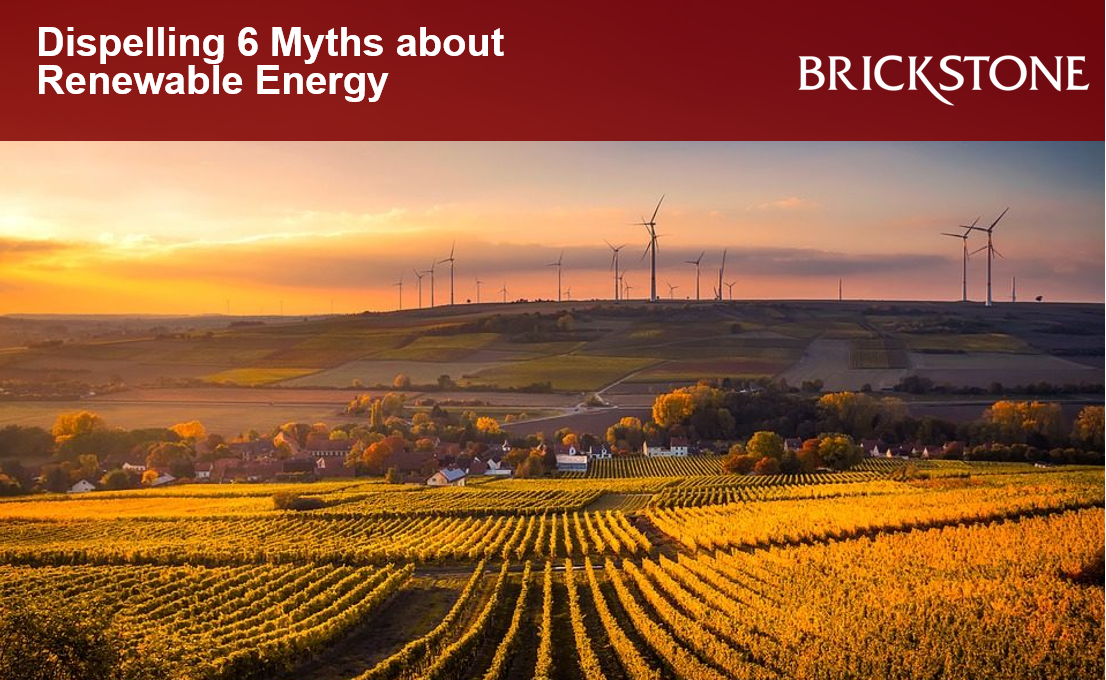Dispelling 6 Myths about Renewable Energy
Renewable Energy in Climate Change
Climate change remains a global menace in the world today. According to Greenpeace, it’s the most serious threat to life on our planet. A recent global study also shows that 80% of the world’s land mass has been impacted by climate change, influencing most of the world’s 7.7 billion people.
Fortunately as a way forward, climate change experts have over the years identified and recommended various solutions to curb this situation. Core to these solutions is reducing greenhouse gas emissions, which must get to zero as soon as possible.
As proffered, changing our main energy sources to clean and renewable energy is one of the best solutions to reducing these emissions and achieving cleaner air. Although they are already the second largest source of electricity worldwide, there are still those who believe the myths about Renewable energy.
This article by Brickstone reviews some institutional reports and publications on common myths about Renewable energy, dispelling the myths with the facts you need to know.
6 Myths about Renewable Energy
A key 2030 Agenda goal urges the decarbonization of the global economy to attain carbon neutrality. According to numerous experts, like Acciona, the installation of clean energy is the most efficient way to realize this goal.
According to studies, midway through this century two-thirds of electricity worldwide will be produced by renewable energies, 40% of global end-user demand for energy will be covered by electricity (compared to 19% in 2017), 63% of which will be generated by solar photovoltaic and wind.
However, there are still people who doubt the efficiency of renewable energies, and give credence to the false myths and rumors concerning their viability. These myths have risen to the surface, and it’s bout time these assumptions were challenged.
The following are common myths about Renewable energy and the facts you need to know that dispels them:
Renewable energy is inferior to fossil fuels: According to the SLA, for a long time, fossil fuels have reigned supreme, when it comes to fueling vehicles, energizing homes and building, and so on. Though, despite the rivalry between the “old” energy and the “new,” there’s the fact that both are still used till today. In fact, with the right balance of both, maybe this relationship would be serviceable. Although renewable energy won’t be 100% implemented in many things worldwide, you should still consider reducing the amount of fossil fuels that you use in your day-to-day life. This doesn’t mean that renewable energy is 100% inferior to fossil fuels. Instead, renewable energy can be used in certain areas, if not all. So, inferiority isn’t warranted here.
Intermittency makes renewable energy unreliable. According to the World Economic Forum, conventional thinking has long held that renewable energy intermittency makes solar, wind and other green alternatives too unreliable. Thankfully, rapid technological innovation in recent years means this myth is outdated. It’s true that solar energy is only produced when the sun is shining on solar panels. Likewise, wind energy is dependent on the ebb and flow of air currents. But the sheer volume of renewable energy being deployed, the ability to store that energy for longer, and to match demand with supply using software, creates a balanced grid. Based on this, the notion that renewable energy can’t deliver when it’s dark or not windy is a myth about Renewable energy.
The energy transition will be too expensive. The notion that the switch to renewable energy is too expensive for mass adoption; that the government and society cannot bear the massive costs of a full-scale transition is a fallacy. In actual fact, renewable energy is now the cheapest new electricity in countries that make up three quarters of the world’s GDP. It’s not only cheaper; it’s also more efficient. Coal power generation is 35% efficient, meaning 65% of energy is wasted in production and transport. In comparison, electricity powered by renewable sources is virtually 100% efficient at end use and can be produced and managed locally.
Renewable energies cannot cover all the demand. According to Acciona, electricity storage systems have come on leaps and bounds, and the technology could support a 100% renewable electricity grid. A 2019 report from the International Energy Agency (IEA) suggests that by 2024 the world’s solar capacity could grow by 600GW, almost double the installed capacity of Japan. Overall, it says, renewable electricity is expected to grow by 1,200GW in the next five years, the equivalent of the total electricity capacity of the U.S. These statistics reflect that renewable energy has the potential to supply all our needs.
Manufacturing a wind turbine consumes more energy than the machine will be able to generate. A wind turbine, according to Acciona, offsets the energy used to make it in less than a year – and can function for over 30 years. Every wind turbine generates enough clean energy to cover the electrical demand from some 2,000 homes. Moreover, the emissions produced by the manufacture and dismantling of a wind turbine represent around 1% of those it will avoid during its useful life in replacing production from coal, gas or fuel oil power stations, and this without counting the CO2 emitted during the building of those fossil fuel stations, nor the extraction or transport of fuel to those plants.
Wind turbines harm ecosystems and wildlife: According to Acciona, the deaths of birds and bats by collision with wind turbines is much less than those produced by other human-led activities such as roads, railways, buildings or domestic cats, as well as those caused by the air pollution wind power helps to avoid. Every renewable energies project must be accompanied by an environmental impact study before it can be approved by the competent authorities, which establish whether the site is compatible with the nature surrounding it, and corrective measures need to be adopted to minimize any harmful effects.
Read more here.






